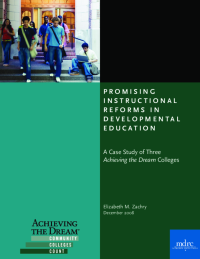Promising Instructional Reforms in Developmental Education
A Case Study of Three Achieving the Dream Colleges
A large proportion of first-time community college students enter schools each year in need of developmental education, but few succeed in making it through these programs to college-level courses, let alone earning a certificate or a degree. As a result, many community colleges participating in Achieving the Dream: Community Colleges Count — a bold, multiyear, national initiative launched in 2003 by Lumina Foundation for Education — are focusing on improving developmental education through a variety of interventions.
The colleges participating in Achieving the Dream receive professional coaching and grants totaling $450,000 over the course of five years. They commit to collecting and analyzing data to improve student outcomes — a process known as “building a culture of evidence.” Specifically, colleges mine transcripts and gather other information to understand how students are faring over time and which groups need the most assistance. From this work, they implement strategies to improve students’ academic outcomes. Achieving the Dream colleges are expected to evaluate their strategies, expand effective ones, and use data to guide budgeting and other institutional decisions.
This report examines the experiences of three of the 83 colleges currently involved in Achieving the Dream and their efforts to improve instruction in developmental classrooms: Guilford Technical Community College in Greensboro, North Carolina; Mountain Empire Community College in Big Stone Gap, Virginia; and Patrick Henry Community College in Martinsville, Virginia. Using the Achieving the Dream model as a framework, each of these colleges implemented a system of reforms aimed at reaching developmental learners who have a variety of skill levels and experiences.
Key Findings
- Each of the three colleges took a unique approach to reforming developmental education instruction. Their reforms sought to meet the varied needs of their student populations, including techniques to increase the success of developmental education students who have low skill levels, techniques to reach developmental education students with higher skill levels, and techniques suitable for learners with a variety of abilities.
- The particular instructional reforms that the colleges instituted tried to accelerate students’ progression through developmental education, to reduce their financial aid challenges, and/or to increase student engagement.
- Most of the instructional reforms that these colleges implemented were still in the pilot stages, but each of them showed promising trends in increasing students’ achievements, as evidenced by evaluations undertaken by the colleges.
- The colleges emphasized that Achieving the Dream had given them a more structured framework for tackling the challenges facing their institutions. The colleges found that they had a greater focus on student success than they had had before joining the initiative.
The report concludes with lessons about the implementation of instructional reforms in developmental education, both for colleges hoping to institute similar reforms as well as for policymakers and leaders who hope to help colleges undertake this work.






